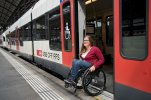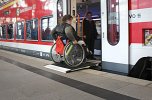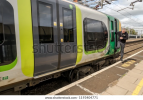I must be missing something here - how aren't powered retractable ramps in a train doorway a decent solution to this vice some slightly odd idea about having an entire train vehicle lower and raise itself at platforms?
I've boarded a bus plenty of times as carer to someone using a wheelchair - they were more than capable of wheeling themselves up the ramp into the bay without my assistance. Why would that be any different for a train so long as the ramp gradient isn't excessive - and if it is, then the platform needs remodelling.
But that is part of my point, due to different levels of platforms the ramp that the guards put down will be at different levels. Some maybe more steep than others depending on the height of the platforms. You also have the issue, depending on the persons issue as to whether they could haul themselves up a ramp without help. This is where either lowering the carriage for the disabled in some way after the train has stopped at the station so that a ramp can come out of it to be level with the platform or having the platforms at the same height, such that gain just like the class 755 units a short ramp just needs to come out such that someone in a wheelchair can wheel themselves on.
But we have to remember that not all disabled are in a wheelchair, some may have sticks to help them walk, some may have a frame to help them walk. Neither are easy to use when you are having to use them up a sloped ramp.
You asked if I’ve ever been in a wheelchair, I don’t want to comment on that. Especially after your increasingly numerous slights against the very railway professionals who enable the railway to operate with increasing levels of safety.
I am only slighting the so called railway professionals that I know have many times refused to put the ramp to allow disabled people to get on a train, which I have not only heard about many times, but also witnessed.
You have stories such as
https://www.disabilitynewsservice.c...orker-was-denied-rail-assistance-three-times/ This goes against the Equality act of 2010 which states "companies that provide public
transport services, such as
buses, trains, the underground and taxis cannot discriminate against
Disabled people and requires them to take steps to make their services accessible for
Disabled people."
I have read many such stories over the last few years, even before some people in the railway profession in the last year gave the excuse about not being able to put the ramp down due to covid-19 even when the wheelchair being used by the person wanting to get on the train had an electric motor built into it, so the guard would not have had to be helping the passenger physically at all.
There is I believe many people within this thread, that have recognised that even though the large majority of people that work in the railway are brilliant when it comes to helping the disabled, there is a few that is letting the side down. Besides what I or anyone is suggesting in this thread are things that will not only make it easier for the disabled person to get aboard a train, but also make life easier for the very railway professionals you believe that I am slighting.



